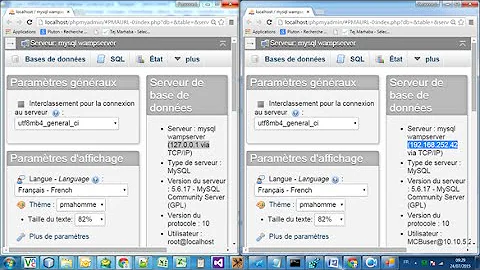Configuring PHPMyAdmin to connect to remote database
You're reading a file in the wrong directory.
The settings are stored in config.inc.php at the root of phpMyAdmin's installation directory; e.g. /usr/share/webapps/phpMyAdmin/config.inc.php. Do not dig deeper than that.
(It's the same place where you can find files config.sample.inc.php, ChangeLog, favicon.ico, and such.)
Related videos on Youtube
Admin
Updated on September 18, 2022Comments
-
 Admin over 1 year
Admin over 1 yearAfter Googling the possibility of using PHPMyAdmin to connect to remote databases, I found this article, which confirms that this is supported after a simple config edit.
In the article, the author explains:
The file config.inc.php contains the configuration settings for your phpMyAdmin installation. It uses an array to store sets of config options for every server it can connect to and by default there is only one, your own machine, or localhost. In order to connect to another server, you would have to add another set of config options to the config array. A set of config options would look something similar to this:
$i++; $cfg['Servers'][$i]['host'] = ''; $cfg['Servers'][$i]['port'] = ''; $cfg['Servers'][$i]['socket'] = ''; $cfg['Servers'][$i]['connect_type'] = 'tcp'; $cfg['Servers'][$i]['extension'] = 'mysql'; $cfg['Servers'][$i]['compress'] = FALSE; $cfg['Servers'][$i]['auth_type'] = 'config'; $cfg['Servers'][$i]['user'] = 'username'; $cfg['Servers'][$i]['password'] = 'password';Pay attention that the config array is called cfg and it's a multidimensional array and that all servers, have to be part of the $cfg["Servers"] inner array. The way this works is by using an incrementing variable $i that sets a different inner array for each server inside the $cfg["Servers"] array. For this to work you need to make sure each new set of config options starts with an incremented $i by using $i++.
However, when I browsed for this file in my PHPMyAdmin files, I found its contents to be different than expected:
<?php /* vim: set expandtab sw=4 ts=4 sts=4: */ /** * Config file view and save screen * * @package PhpMyAdmin-Setup */ if (!defined('PHPMYADMIN')) { exit; } /** * Core libraries. */ require_once './libraries/config/FormDisplay.class.php'; require_once './setup/lib/index.lib.php'; require_once './setup/lib/ConfigGenerator.class.php'; $config_readable = false; $config_writable = false; $config_exists = false; check_config_rw($config_readable, $config_writable, $config_exists); ?> <h2><?php echo __('Configuration file') ?></h2> <?php PMA_displayFormTop('config.php'); ?> <input type="hidden" name="eol" value="<?php echo htmlspecialchars(PMA_ifSetOr($_GET['eol'], 'unix')) ?>" /> <?php PMA_displayFieldsetTop('', '', null, array('class' => 'simple')); ?> <tr> <td> <textarea cols="50" rows="20" name="textconfig" id="textconfig" spellcheck="false"><?php echo htmlspecialchars(ConfigGenerator::getConfigFile()) ?></textarea> </td> </tr> <tr> <td class="lastrow" style="text-align: left"> <input type="submit" name="submit_download" value="<?php echo __('Download') ?>" class="green" /> <input type="submit" name="submit_save" value="<?php echo __('Save') ?>"<?php if (!$config_writable) { echo ' disabled="disabled"'; } ?> /> </td> </tr> <?php PMA_displayFieldsetBottomSimple(); PMA_displayFormBottom(); ?>Does anyone know where/how, in the more recent versions of PHPMyAdmin, this config data is stored and can be edited?
-
 Suresh Kamrushi over 8 yearsA detail blog: goo.gl/FZ6nqD
Suresh Kamrushi over 8 yearsA detail blog: goo.gl/FZ6nqD
-
-
 Admin about 10 yearsYep. Just discovered that, thanks. Tricky duplicate file names... Anyway, I'll accept this when the timer is up!
Admin about 10 yearsYep. Just discovered that, thanks. Tricky duplicate file names... Anyway, I'll accept this when the timer is up! -
 Admin about 10 yearsLooking at this, it's a very weird albeit creative way to build a config.
Admin about 10 yearsLooking at this, it's a very weird albeit creative way to build a config. -
 Admin about 10 yearsOnce I updated the config, I got the option to connect to the remote database as expected, however, phpMyAdmin seems to be trying to use the password 'YES' rather than the one supplied in the config. Could you have a look at the updated config for my error? gist.github.com/jt0dd/11314779
Admin about 10 yearsOnce I updated the config, I got the option to connect to the remote database as expected, however, phpMyAdmin seems to be trying to use the password 'YES' rather than the one supplied in the config. Could you have a look at the updated config for my error? gist.github.com/jt0dd/11314779 -
 Admin about 10 yearsAh, I see. That's my issue. Since 'user' alone is input whe dealing with mysql from the console, I didn't realize that the username takes that format.
Admin about 10 yearsAh, I see. That's my issue. Since 'user' alone is input whe dealing with mysql from the console, I didn't realize that the username takes that format. -
user1686 about 10 years@jt0dd: Clients (including phpMyAdmin) always use just the username, yes. The server gets the address directly from the OS after all. And "user"@"address" is just what the server searches for in the user table. My point was, if your account was created as "jt0dd"@"localhost" it won't work over the network.
-
 Admin about 10 yearsI see, I see! I just attempted to use 'root@<serverIP>' and was confused when phpMyAdmin tried
Admin about 10 yearsI see, I see! I just attempted to use 'root@<serverIP>' and was confused when phpMyAdmin triedroot@serverIP@myIP- erm. I'm confused now, actually. phpMyAdmin sendsroot@myip- the remote MySQL server expectsroot@serverip? I must have that wrong. -
 Admin about 10 yearsOk, that's confusing. Perhaps I should post a new question for that solution
Admin about 10 yearsOk, that's confusing. Perhaps I should post a new question for that solution -
user1686 about 10 years@jt0dd: PMA sends
root. The server translates it toroot@clientip(I'm quite sure it's the client address, not the server address), and if it sends an error, you see the translated form in the error message.




